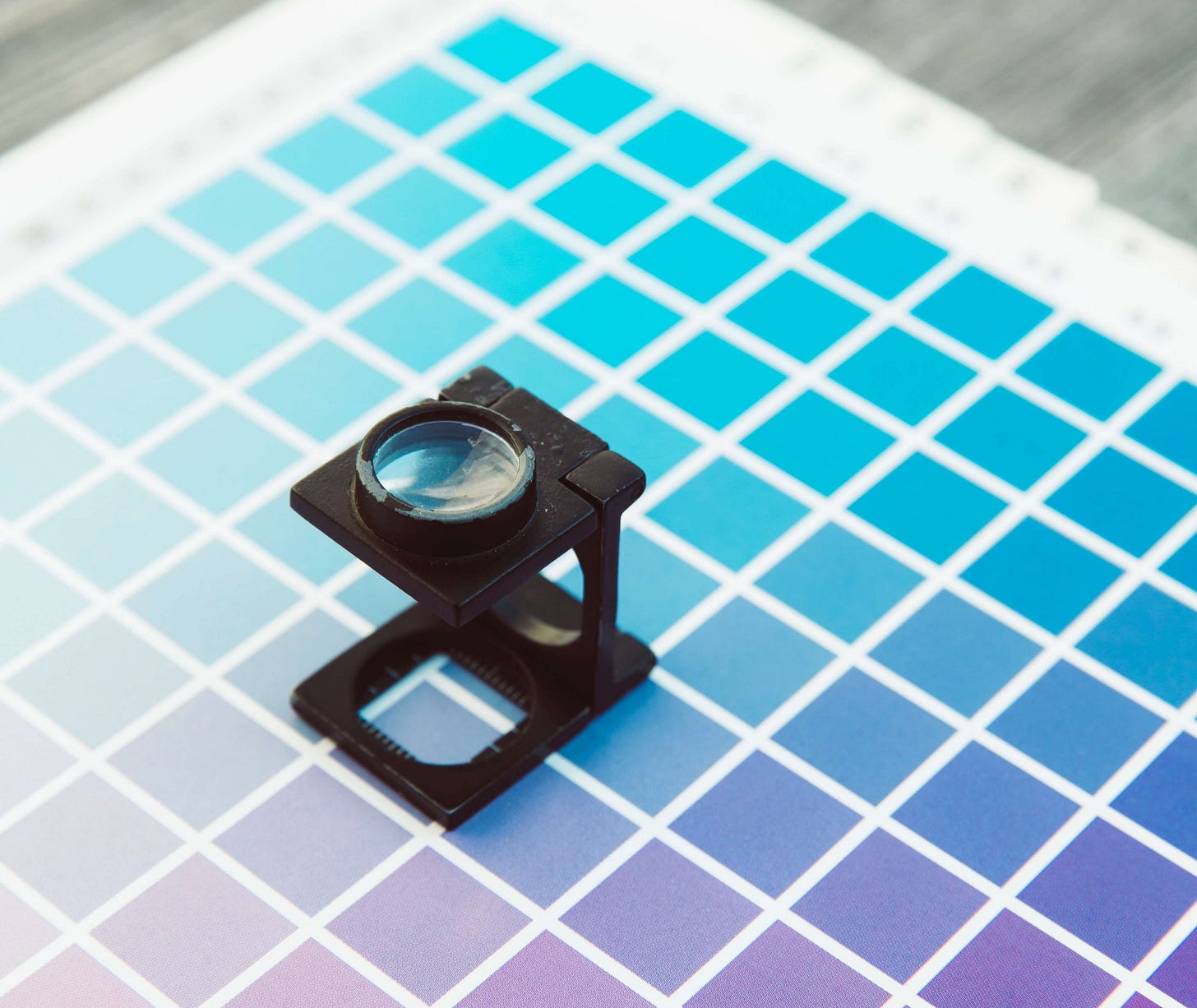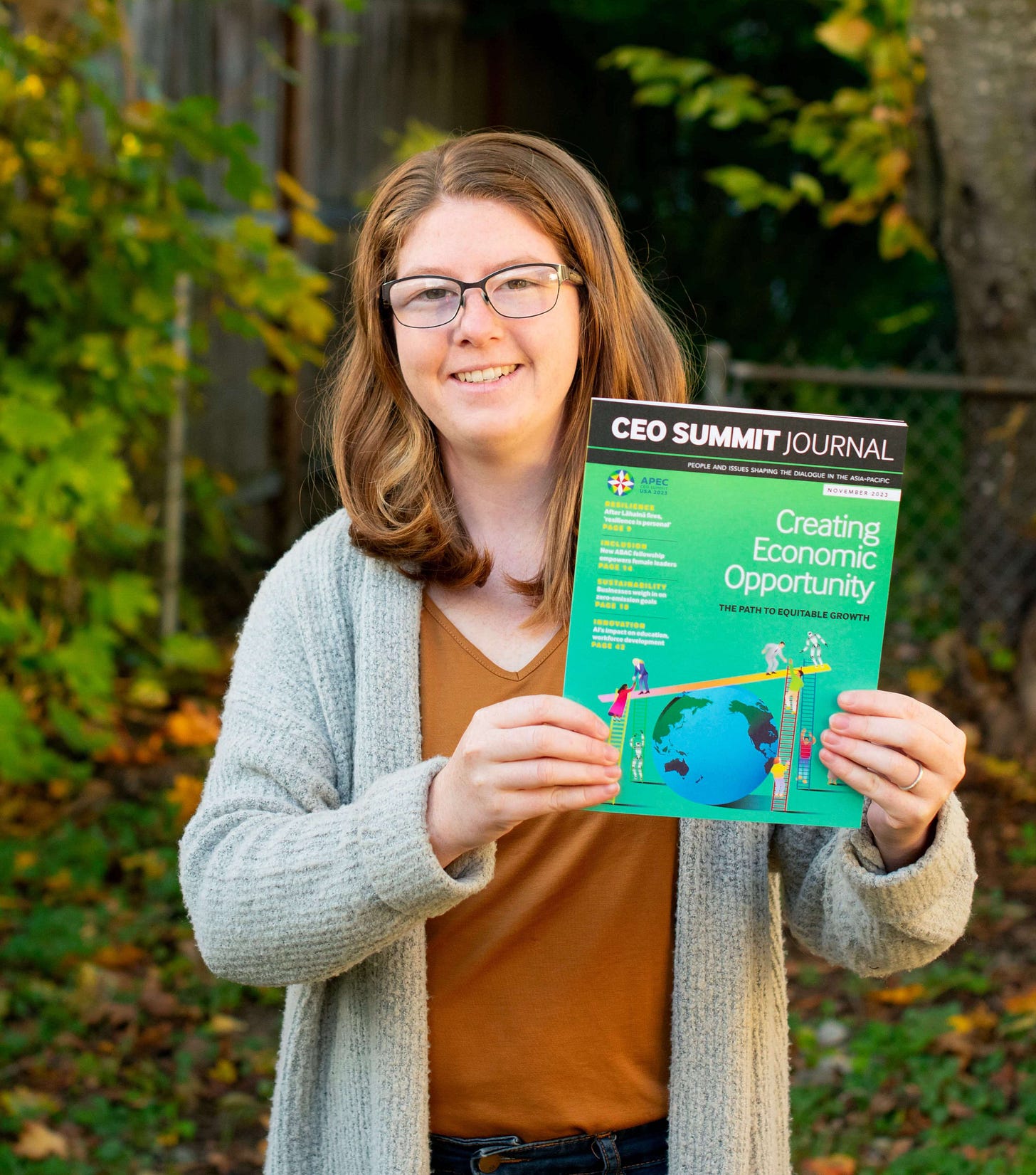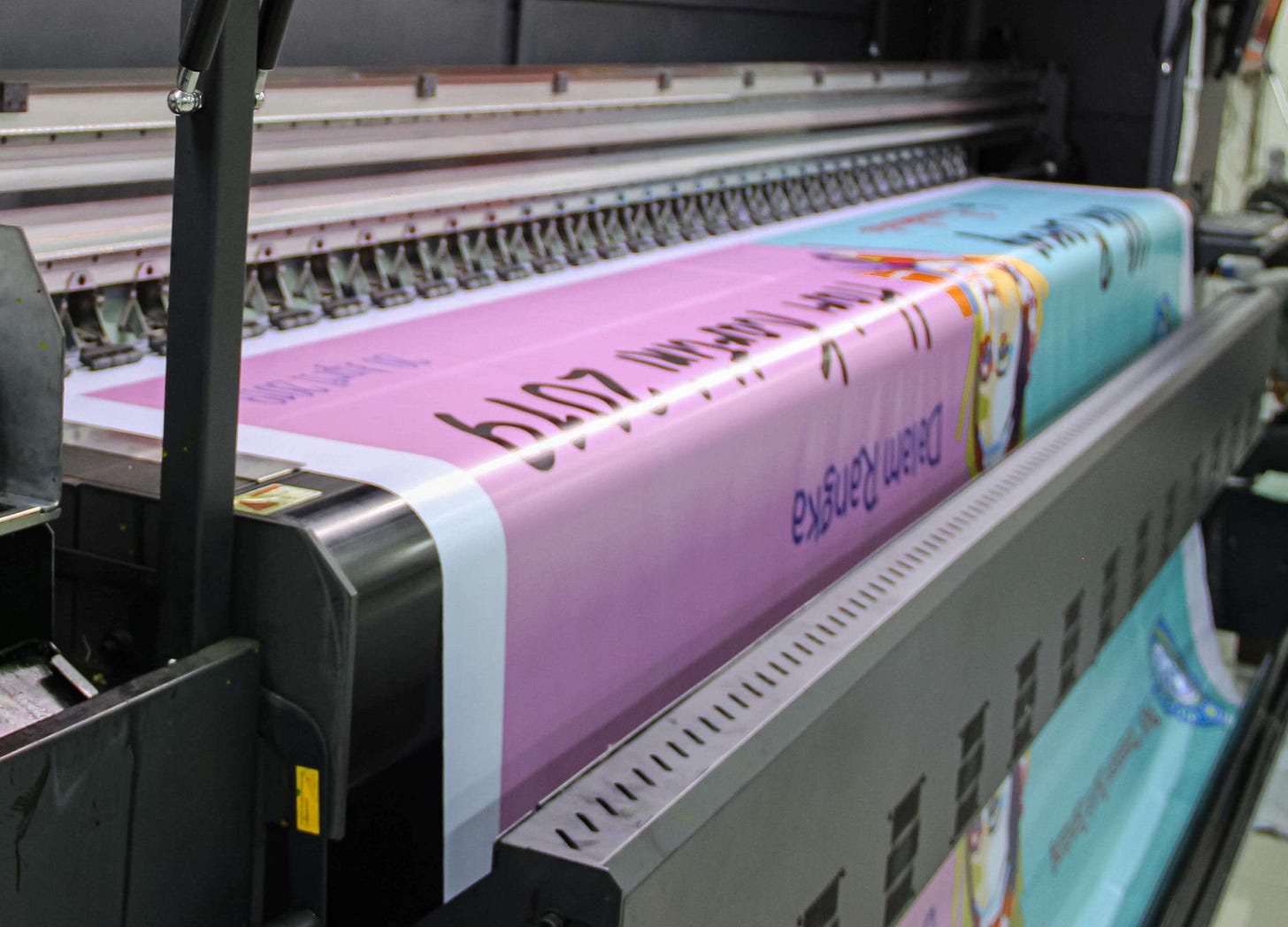How to find the right printer
And why you should consider looking locally before searching online.
Something I get asked a lot by clients is “how to find a printer”, so this is my guide to help you find the right one for you.

Finding the right printer is no small feat, but there are just a few things to consider to help you sort through your options. I’ll break them down one by one to help you think more deeply to feel confident in your printer selections.
Quick overview:
1. What do you need printed?
2. Your Budget
3. Quality
4. Deadline
5. Aligned values?
Please note that these are not in order of importance, all these variables impact one another and all play a role in helping you make the best decision for you. After reading through these guidelines, take a step back and narrow down the top two or three that you want to prioritize to help you make a final decision when searching for your next print partner.
1. What do you need printed?
Printers can help you create all sorts of marketing and promotional materials, so you can start by considering the variety of products that you might need (both now and in the future). Some examples include: wide format, custom packaging, apparel, stickers, postcards, stationary, etc.
In an ideal world, you find a great printer who offers all of these services, so you can keep working with them instead of having to do additional research every time you need to print something new. However, you’d be hard pressed to find a printer who does everything at the same level of expertise. If they are known for creating best-in-class posters, they can’t necessarily create the best embossed hat.
On another note, printers don’t offer all the same products, so you have to dive in to see what they can and cannot help you with.
Pro tip: Do all your research at once and take notes about your top picks for different products that you would like to order in the future. Planning ahead can save you time and money.
2. Your Budget
Just like any decision nowadays, you need to consider your budget and the price of the print services. If you don’t have one, you should probably start thinking about one for each print project as printing costs play a large role in the end costs for marketing and promotional materials. Don’t be afraid to crunch some numbers to see what is the best decision for you.
Anymore you can’t assume one place will be cheaper than another. Printers like Vistaprint who were known to be cheap have grown in popularity, so I’ve seen their prices rise to accommodate demand over the last few years. I think part of this is due to brand recognition as well, as they pushed hard to market themselves and now everyone seems to know who they are—yay for the power of branding and marketing.
Look at several options and compare the per piece prices (at the same quantities) to get the best idea of what a project will cost to print.
Maybe you spend a bit more and get something with special finishes to help you stand out from the crowd? Or maybe things are tight and you need to sacrifice print quality and put more time into the design to create more impact?
Pro tip: Ask your printer where the price breaks are if you are shopping in store. If you’re searching online, you can see these by looking at the quantities and per piece price (this might not be listed, but you can find this by taking the total cost and dividing it by the number being printed).
This might help you decide how many to order if you don’t have a number in mind already. Price breaks happen when the per unit cost goes down as you order more.
3. Quality
This might be impacted by your answers to the last section. If you’re working with a smaller budget, you might not be able to get the highest quality prints. Lucky for you, there is a huge range of printers with varying qualities, so you still have lots of great options to work with.
What quality of paper do you want? Do you want any special finishes (foil stamping, spot UV, die cutting, embossing, debossing etc.)? Does the printer have good reviews or can you go in to view samples before you print?
Pro tip: Order a sample kit from your printer, especially when ordering online, they vary in size and contents but they all accomplish the same thing—showcase the work of the printer and paper options they have available. Sometimes these are free and sometimes you have to pay for them, but it’s worth every penny.
This can give you a better idea of how thinks look and feel when they come off the press. Taking designs from screen to print makes a huge impact on the final product, so these kits allow you to feel the paper and have a better idea of what to expect.
Another pro tip: If a printer does not set you up for success by providing print specifications anywhere on their website, it’s really hard to know what kind of quality will result. Print specifications act as a guide and tell you exactly what they need from you in your artwork to create the best possible outcome. If they are not thinking about all the little details, you might consider looking elsewhere.
4. Deadline
Deadline is a big factor when selecting who you can print with. If you need something tomorrow and an online printer has a 3-5 day production time with a minimum of two day delivery, you are not going to be able to work with them.
This is especially important for printed products that are tied to specific events. Perhaps you are an illustrator and need some new art prints to sell at your upcoming market, or you might be a business owner printing fliers for your next workshop. You need to factor in production and shipping time to determine when you need to get final artwork to the printer, unless you want to pay a rush fee.
Pro tip: Use these details to determine an artwork deadline for your designers (or yourself) and add at least a few days buffer from the delivery date for the unexpected. If you are designing yourself, check the printer’s website or ask for print their specifications, so you can ensure they can begin printing with no issues.
5. Aligned Values?
When looking at all the printing options for your business, you should think about your business values. If you are a mission driven non-profit that focusses on beach clean-ups, you should probably work with a printer who doesn’t use plastic in their packaging materials and print services. See where I’m going with this one?
”86% of younger consumers (18-44) are willing to pay more for products in sustainable packaging.”
2022 Global Buying Green Report by Trivium Packaging
I wanted to include this as a reminder to look at the values that help drive your business forward and make a decision that aligns with who you are at the core.
Is the printer paying their employees fair wages? Are they working in safe conditions? Do they care about their environmental impact? Do they use plastic packaging?
The list of questions could go on and on and is dependent on your values, so take some time to reflect before moving forward. These answers could also help you make a final decision when considering your top two or three selections.
Pro tip: Check out their website and see if they list their business values anywhere (About page is a good place to start), do some of them align with your own?
Printing Local
Whenever I get asked about printing options, I always start by explaining some of the benefits of working with a local printer:
They may allow you can print smaller quantities (no or low minimums)
No shipping costs, as you can pick up in person (also lowers carbon emissions from transportation)
Sometimes you can get it within 24-48hrs
If they can’t print what you need, they might be able to direct you to someone else who can or they might be able to outsource.
Less packaging waste!
Support your community and fellow business owner
Perhaps the biggest benefit is that the people who work there can give you recommendations on paper stocks and answer any questions that you have before working together.
I might be a little biased since I used to work at a small print shop, but forming a good working relationship with your printer makes printing more enjoyable for all involved.
Printer Recommendations
I always recommend searching locally first, but you might not have anything available near you. If you are local to Portland, OR, feel free to reach out for local recommendations—or feel free to share your area and favorite local print shop down below. Here are a few of my top picks for online printers.
My favorite online printers are Noissue and Ecoenclose—primarily because they align with my values as they both have sustainability at the forefront of their business.
For top notch quality, customer service and precision Hemlock (North America’s leaders in sustainable print practices). I just worked with them for the first time on the journal project I talk about below and they totally blew me away!
I encourage you to start thinking of your printer like a business partner, they can provide valuable insight into the printing process and can help guide you to create better products for your business as you grow. If you find one that communicates well and does great quality work that also fits your budget, hang onto them for as long as you can.
I’ll likely continue to update this post with new print recommendations and tips for finding the right printer for you. If you’ve got a tip that has helped you or have other printer recs, feel free to add it in the comments below.
Studio updates
As you know, I’ve been a bit silent after my first post here, sorry for that, I’m in a bit of a transitional time right now (I’ll get into that later) and don’t know where the last two months have gone. I’ll start with a quick recap of the last couple months so you know what I’ve been up to, then I’ll get into upcoming changes.
October was filled with one major project—a 64 page journal that I worked on with a small team and a tight deadline. I was one of two designers working to bring this journal to life and was also managing communication between all involved. We were working like we were in a full time role at a big corporation—evenings, weekends, you name it. Always on call and always thinking about what we had to do next. I learned a lot and honestly gained a lot of confidence by the end of it, and we pulled through to create a beautiful journal.
Also shoutout to the illustrator who worked on the cover art, Yifan Wu; we didn’t personally connect during the project, but she does wonderful work. You can check out her portfolio here.

At the end of October, I attended a virtual workshop hosted by Michelle Miller from The Green Marketing Academy all about “Infusing More Accessibility into your Messaging” led by the lovely Laneen Wells from Sublation Studio. You might notice that some better captions, image descriptions, and alternate text to go along with my images—HUGE thank you to Laneen for making accessibility seem more manageable and less overwhelming. Still learning and growing in the world of accessibility, if you’ve got any tips, send them my way. If you want to learn more about accessibility, check out and subscribe to Laneen’s SBLTN Lab Notes to learn more.
November has been filled with change. It’s getting colder here in Portland, OR and I went from swamped with work to no new leads real quick. I’ve got a few lingering smaller projects, but nothing big is in the works. Currently, I’m asking my community for any connections that could benefit from ongoing design work. I’d love to find a couple of retainer clients searching for consistent design support.
I’ve also started applying to a few full-time roles. If you have any leads on design positions with a focus on branding, packaging, or impact-driven—send them my way, I’m looking in all directions and appreciate any new leads.
What sparked this pivot? If I’m being totally honest (I always try to be), I’ve got student loans to pay off and want to work towards more financial freedom. They forever loom in the back of my mind and definitely cause some unwanted stress. I also had a few clients this year that made me think about walking away completely. Sometimes you have a few bad experiences and it makes you forget about all the good projects and progress you’ve made.
That being said, I’m still planning to freelance while settling into whatever is next for me. Renee Lynn Creative has grown a lot this year and I’m excited for the changes to come. Availability will be dependent on the role that I find; if it is longer contract work or something part-time I’ll have more flexibility, but if I do end up in something full-time it will likely be pretty limited. Perhaps only one big project every month or maybe even every two months. Although I’m making a lot of changes, I think this is all for the better. I will be more selective about who I am working with and will be able to give them more one on one attention to each project—hopefully leading to a better experience for all involved.
My mantra for next year is “Community, Connection and Collaboration.” Moving forward I want to support my fellow business owners in a deeper, more intentional way: more phone calls, more video chats, more throwing ideas back and forth. I have a bunch of posts drafted here on Substack and I’ve been brainstorming a lot of cool passion projects—working out ideas for a collaborative blog or podcast with my friend Angela from Simply Growing Joy and starting a creative brief account centered around fictional eco-focused businesses started on Instagram. If either of those interest you, please connect—I want to hear from you!
To bring things to a close today, I want to leave you with this. You are not alone, you are doing a good job and you have the ability to change the trajectory of your life at any moment. Pursue things that bring you joy, adapt your businesses so it better suits you, and lean on each other. Life is weird, twisted, and challenging but good things happen when we come together.
Thanks for being here and taking sharing your time with me. I hope you've been well and are on your way to finding your place in the world. Until next time (I promise it won’t be as long this time!—Planning for a second post this month!).
Renee



